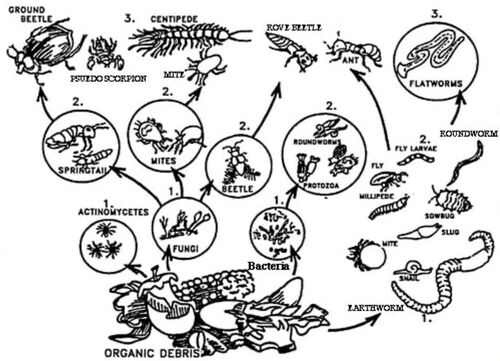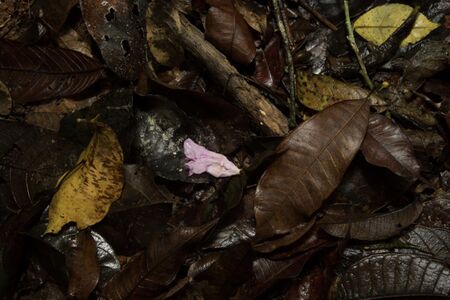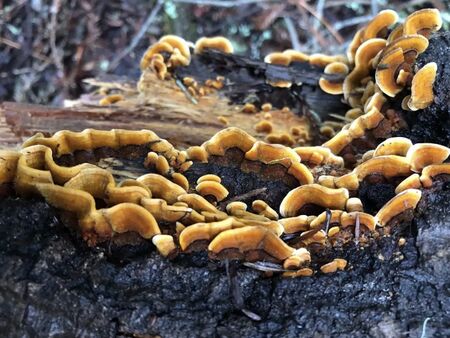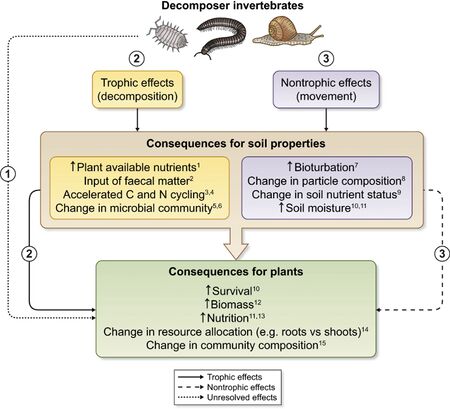Decomposers
Definition
Decomposers are organisms which break down dead or decaying organic material. This most commonly includes bacteria, fungi, and invertebrates. The material broken down in decomposition is referred to as detritus. Detritus is matter composed of leaves and other plant parts, animal remains, waste products, and other organic debris that falls onto the soil or into bodies of water from surrounding terrestrial communities. [1]
Function
The purpose of decomposers is to carry out the decomposition process of organic matter. If organic matter did not go through the decomposition process, nitrogen would be “locked” in organic tissue making environments nutrient scarce. [3] Decomposers combat this by breaking down decaying matter and allowing nitrogen to continue to cycle through the environment. Making nutrients readily available provides the fuel needed for plants to grow.

Figure 1 Decomposers food web showing the energy transfer of decomposition. [2]
Decomposers break organic material into smaller fragments in a process known as fragmentation. [3] Invertebrates serve as the initial organisms which fragment organic material. After initial fragmentation, smaller soil bacteria and fungi serve to fully degrade nutrients. Small fragmented materials have increased surface area which allows for the increased growth of both bacteria and fungi.
Diversity
Bacteria
Soil bacteria make up a large portion of decomposers. Generally, decomposing bacteria function best in warm and moist environments. For this reason, decomposition occurs rapidly in tropical rainforests. When detritus build up if high, moisture is more easily maintained in soils. Increased moisture and warmer temperatures allows soil bacteria to grow and thrive. [6]
Bacterial decomposition on the forest floor. [6]
Fungi
Fungi are primarily multicellular eukaryotic organisms that are heterotrophic and play an important role in nutrient cycling within ecosystems. [4] There are both “good” and “bad” fungi in a given environment. “Good” fungi may serve to aid a plant in the uptake of nutrients while “bad” fungi can be responsible for impacts related to disease. Fungí communicate with plants through their hyphae networks called mycelium. [4]
Fungi serve a large role as decomposers. They can be either generalists or specialists. The most important function of fungi as decomposers is to provide growing plants with nitrogen. Nitrogen is provided in soil when fungi break down decaying organic material.
Fungi decomposing a decaying log. [5]
Invertebrates
Soil invertebrates contribute to the recycling of dead plant material. [7] Invertebrates contribute to decomposition by breaking down organic matter with their own endogenic enzymes. These enzymes are vital to the decomposition process as they degrade lignocellulose present in plant material. The most notable decomposers invertebrates are earthworms, termites, woodlice, snails, millipedes, beetles, and mesofauna. [7] Their abilities to break down dry plant matter make them valuable decomposers. As seen with other decomposers, invertebrates increase soil nutrient availability for plants. The nutrients directly increase leaf, root, and stem growth. Positive growth impacts vary based on the plant and uptake levels. Invertebrates do not only directly break down organic matter but also increase soil moisture further enhancing nutrient uptake. Mesofauna, such as Collembola, are associated with an increased number of plant leaves and higher nitrogen content in soils. [7] Increased presence of invertebrates has been associated with higher root to shoot biomass.
Invertebrate decomposers and their interactions with their environment. [7]
References
Citations
- Lotha, Gloria. “Detritus.” Encyclopædia Britannica, Encyclopædia Britannica, Inc., 15 May 2020, https://www.britannica.com/science/detritus.
- “Organisms in Composting.” Texas A&M AgriLife, Aggie Horticulture, Feb. 2009, https://aggie-horticulture.tamu.edu/earthkind/landscape/dont-bag-it/chapter-1-the-decomposition-process/. Accessed 1 Apr. 2023.
- University, Utah State. “Decomposition: Herbarium.” Utah State University, https://www.usu.edu/herbarium/education/fun-facts-about-fungi/decomposition.
- Editors, BD. “Fungi - Definition, Types and Examples.” Biology Dictionary, 4 Oct. 2019, https://biologydictionary.net/fungi/.
- “Decomposing Fungi.” National Parks Service, U.S. Department of the Interior, 16 Sept. 2021, https://www.nps.gov/muwo/learn/nature/decomposing-fungi.htm.
- “Decomposition: How Nature Recycles.” Decomposition - How Nature Recycles , 2023, https://www.edtechlens.com/blog/rainforest-kids-science-decomposition-nature-recycles.
- Griffiths, Hannah M, et al. “The Impact of Invertebrate Decomposers on Plants and Soil.” New Phytologist Foundation, New Phytologist, 15 June 2021, https://nph.onlinelibrary.wiley.com/doi/10.1111/nph.17553.


